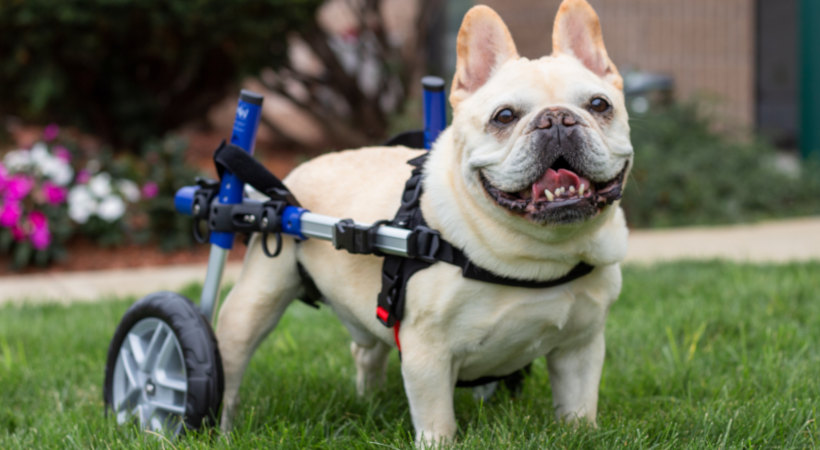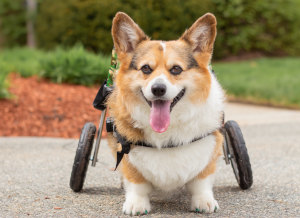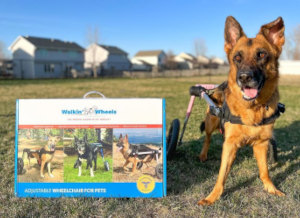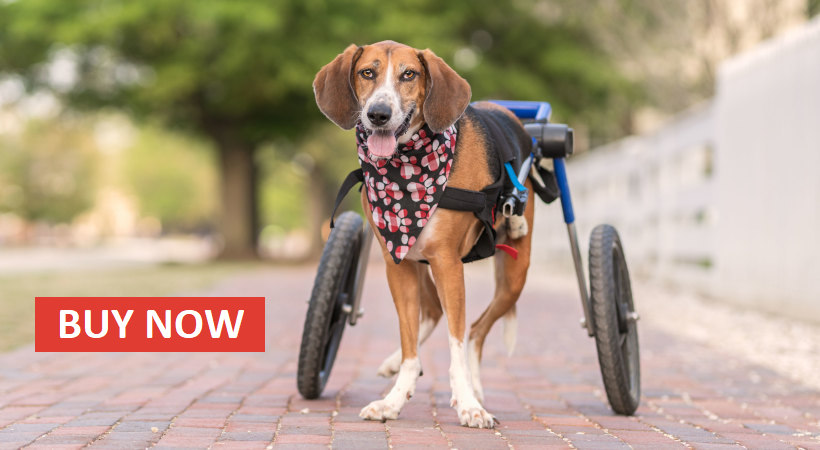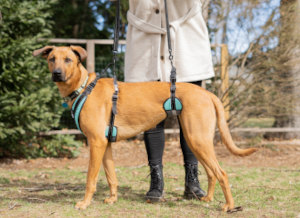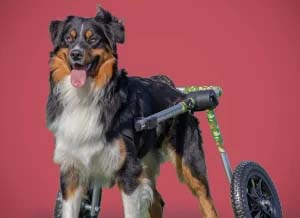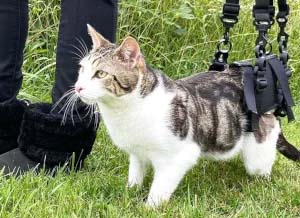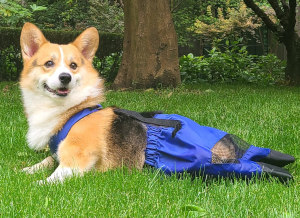Whether your elderly dog’s back legs are weak, your dog can’t walk due to an injury, or your pet’s hind legs have become paralyzed, watching your pet struggle to walk is heartbreaking. However, just because your dog is dealing with mobility challenges, it doesn’t need to impact its quality of life. Let’s review a few of the most common questions pet parents have regarding their dog’s inability to walk.
What happens when your dog can’t walk?
When a dog cannot walk, expect significant changes in your dog, both physically and mentally. A dog with difficulty walking will likely rest far more often, which can significantly change your physical well-being. A less active dog may be prone to weight gain and atrophy in their back legs from lack of exercise. The loss of muscle mass will be visible across the entire hind end, including the rump.
Pets that become full immobilized will spend a lot of time resting, and because it can be difficult for them to reposition themselves, they will likely stay in one position. However, pressure sores can form on their legs, hips, and throughout their body if they are not shifted and moved regularly.
Not getting enough exercise also takes a mental toll on a dog. Your dog needs stimulation. A lack of activity can lead to canine depression and increased lethargy. Therefore, it’s imperative for your dog to stay active, motivated, and engaged regardless of its mobility challenges.
What’s a dog’s quality of life if they can’t walk?
A senior dog with mobility loss can have an excellent quality of life. However, assessing this decision isn’t one you have to make on your own. Your veterinarian will advise you on your dog’s quality of life and what it needs to stay active. There are a few questions to ask yourself. First, is my dog in pain? A dog can not be in pain and be happy. If your dog’s pain can be managed through medication or therapy, then there is no reason why the loss of mobility has to be an end-of-life decision.
Secondly, does your dog still enjoy their life and want to get around? Dogs with the will to stay active and engage with their families are great candidates for mobility assistance. The key to your dog’s happiness is giving them the tools they need to remain healthy, pain-free, and active. It’s possible for a dog that can’t walk to live a long and happy life.
What to can do if your dog can’t walk
1. Know the Signs
Take note of any behavioral or physical changes you’ve seen in your dog. For example, has your dog struggled to climb the stairs? Are they eating less or sleeping more? How long has your dog been showing these signs? Did the inability to walk come on suddenly? The answers to these questions are crucial to help your veterinarian to diagnose your dog.
Common signs of canine mobility loss include:
- Shaking or trembling, especially in the legs
- Dog tires quickly and may be unable to go on long walks
- Tipping over or suddenly losing its balance
- Unable to push up off the ground to stand or rise slowly
- The dog struggles to climb the stairs, jump on furniture, or get into the car
- Dog’s back legs collapse underneath them
- Paralyzed back legs and loss of leg function
Many elderly dogs that can’t walk will exhibit various symptoms; every dog is different. However, if your dog is having a hard time walking without your help or is struggling to get around, they must go to see their veterinarian. Only a pet professional can diagnose your dog and ensure you know how to care for your best friend.
2. Invest in a dog wheelchair for back legs.
A dog’s legs may become less functional due to disease, which is more common among certain breeds than others. Of course, paralysis, loss of limbs, or other forms of significant mobility loss can be due to injuries, like being hit by vehicles, falling in an unfortunate way, or in very sad cases, due to abuse.
The good news is, whether due to the natural process of aging, or disease or injury, a Walkin’ Wheels dog wheelchair can give years of high quality life to dogs — and restore their independence!
Normal aging — or an injury or illness — no longer has to be a reason to have a dog put down. A set of wheels can make a high quality of life possible for dogs and is a practical solution for pet owners.
How a Dog Wheelchair Works
A rear wheelchair acts as a replacement for your dog’s back legs. In addition, a canine mobility cart is beneficial for dogs with limited use of their back legs, weak hind legs, or dogs with completely paralyzed rear legs. Walking in a dog wheelchair is great exercise too!
Continued mobility will allow your dog to maintain their muscle mass, prevent atrophy, and help them rebuild their leg strength. But, just like humans, if your dog doesn’t use it, they’ll lose it. In addition, dogs need to exercise to stay healthy. The support of a wheelchair can slow down the progression of the dog’s mobility loss, and the more active the dog is, the better its overall health.
3. Find a dog support and rehabilitation harness
Although a dog wheelchair is a life-changing mobility device, it won’t work in every scenario. For example, a dog that can’t walk will need help navigating the stairs, getting out of the car, and may need to get outside quickly to go to the bathroom. A dog support harness is a great way to lift and carry your dog in these scenarios.
Most lifting harnesses are comfortable enough for your dog to wear all day. When shopping for a support harness, look for one compatible with a dog wheelchair and support your pet exactly where they need it.
4. Consider canine rehabilitation
Working with a certified canine rehab practitioner is a great way to keep your dog active. A CCRP will create a customized treatment plan that will benefit your dog even if they can’t use their back legs. During rehab exercises your dog’s rehab specialist will work on strengthening their back legs, improving balance, preventing further muscle atrophy, and help your dog relearn how to place their paws while walking. A range of modalities may be used for a dog’s rehabilitation including hydrotherapy, laser therapy, massage, and structured exercises just to name a few.
